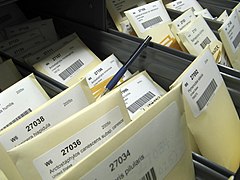Seed library
The seed library is understood to mean the collection of seeds including their description with regard to their location, year of origin, thousand-grain mass as well as the botanical classification, genetic origin, phenotypic expression and description of the respective plant variety.
history
The beginnings of seed collections go back to the settling down of mankind. It initially referred to keeping the harvested crops of the most productive cereal plants from different locations separately, labeling them accordingly and using them for sowing in the next sowing season in a location-appropriate manner. The first scientifically documented public seed library was set up in the 16th century by Leonhart Fuchs in connection with the Botanical Garden of the University of Tübingen .
Technical requirements
Dry seeds with max. 14% moisture content loses 1–5% germination capacity annually in the unconditioned storage room . In cold rooms and hermetically sealed semen containers, this risk of loss drops to a few per thousand. The occasional germination tests ensure that the declining germinability of the stored varieties is recognized in good time and the seed samples are replaced by sowing and a new harvest.
Seed library sponsors
Today, seed libraries exist as:
- University and teaching libraries in many educational institutions. These mainly serve as the basis for basic research and the training of botanists , farmers and gardeners .
- State Seed Libraries. They ensure the genetic diversity of the cultivated plants of a region, a state or even transnationally, such as the herbarium as well as the cultivated plant bank and gene bank information system of the Leibniz Institute for Plant Genetics and Crop Plant Research in Gatersleben. and the global seed vault on Svalbard ( Svalbard Global Seed Vault ).
- Breeding libraries of the seed breeding companies . In connection with the breeding programs and performance test results, they are the assets of these companies and the basis for further research and corporate success.
- Plant variety protection library of the plant variety offices . This preserves seed as a reference pattern by plant variety protected varieties on. On the basis of the seed propagation brought onto the market every year, its compliance with the stored sample and compliance with the legal regulations for seed sales are monitored.
- Crop Plant Gene Libraries . The largest gene bank is the Svalbard Global Seed Vault in Longyearbyen on the island of Spitsbergen , a transnational seed collection of useful and wild plants. This seed library is an attempt to save up to 4.5 million seed samples as the plant genetic resources of the earth for future generations in the station at minus 18 to minus 20 degrees Celsius.
The seed distribution stations of non-governmental organizations (NGOs / NGOs), some of which are referred to as variety libraries, such as the Navdanya station in India, are not seed libraries in the traditional sense. These stations should contribute to the preservation of the regional diversity of crops and serve the direct seed supply of small farmers.
Description of the seeds
The description of the individual seed samples usually contains information on:
- The seeds: number of grains, thousand grain mass , shape variance, water content, ingredients, harvest or growth year, germination capacity and driving force and year of their determination and method used.
- of the plant species: botanical classification; by genus , species , variety and their phenotypic and, if possible, genetic description.
- the genealogy of useful plants : original origins and family tree, storage location of ancestral places.
- Plant variety protection: Notes on the property and protective rights of pre- basic seeds , inbred lines , cross parents and registered varieties and their duration of protection .
See also
- Bundessortenamt
- Federal Association of German Plant Breeders
- Gene library
- Gene bank
- International Seed Testing Association (ISTA)
- International Union for the Protection of New Varieties of Plants in Geneva (UPOV)
Web links
- Federal Information System Genetic Resources (BIG) contains references to seed libraries
Individual evidence
- ^ Herbarium and seed collection of the IPK Gattersleben
- ↑ Information on Navdanya's action to conserve biodiversity
swell
- Manfred G. Raupp: Thoughts on the situation in German agriculture, its further development and the consequences for activities in the field of seeds, genetic engineering and industrial raw materials. Ciba-Geigy Frankfurt 1985
- Siegmund Seybold : Flora of Germany and neighboring countries. A book for identifying vascular plants that grow wild and often cultivated . Founded by Otto Schmeil , Jost Fitschen . 93rd completely revised and expanded edition. Quelle & Meyer, Wiebelsheim 2006, ISBN 3-494-01413-2 .
- Adolf M. Steiner and M.Stahl: Seed storage potential of population varieties and hybrid varieties and their breeding components in rye (Secale cereale L) Stuttgart-Hohenheim 1998
